Direct Sunlight Analysis: A Simplified Approach to Complex Residential Design
Abstract
1. Introduction
2. Materials and Methods
2.1. Methodologies
2.1.1. Theoretical Research
2.1.2. The Program Methodology
- Vector from the Sun: Generate a vector from the sun’s position connecting obstacle points and openings in a room. This vector is employed to project sunlight and shadow onto a designated surface, with the sunlight area calculated by excluding the intersection of sunlight and shadow.
- Reverse Vector: Create a vector from a specific point towards the sun’s position. If this vector encounters no obstacles and successfully reaches the sun position, the corresponding point receives sunlight.
2.1.3. Validation and Comparative Study
2.2. Case Studies of the Research
2.3. Literature Review
2.4. Sunlight Vector Method Concept
2.4.1. Obtaining the Shadow Area of Surrounding Buildings and Above Floors (Figure 3)

2.4.2. Subtracting the Area of Sunlight and Shadow (Figure 4)
- Considering only high-altitude direct sunlight: At low solar altitudes, the projected sunlight area on the working plane becomes distorted, as sunlight primarily strikes surrounding wall surfaces. Accounting for these effects would require additional calculation planes, increasing computational demand. To maintain analytical consistency and improve efficiency, this study limits analysis to sunlight projected onto the working plane, excluding sunlight on walls and that from excessively low solar altitudes.
- Wall thickness at the opening is assumed to be zero: Although walls possess physical thickness that affects the actual sunlight penetration area depending on solar position, apartment units generally share consistent window and façade designs. Thus, this study assumes zero wall thickness at all openings to simplify computation and improve efficiency without compromising the reliability of the sunlight index.
- Excluding bounce light and material effects on sunlight: As this study focuses exclusively on direct sunlight, secondary effects such as bounce light and material properties are excluded from the analysis. This simplification reduces modeling complexity and computation time without affecting the validity of the direct sunlight evaluation.
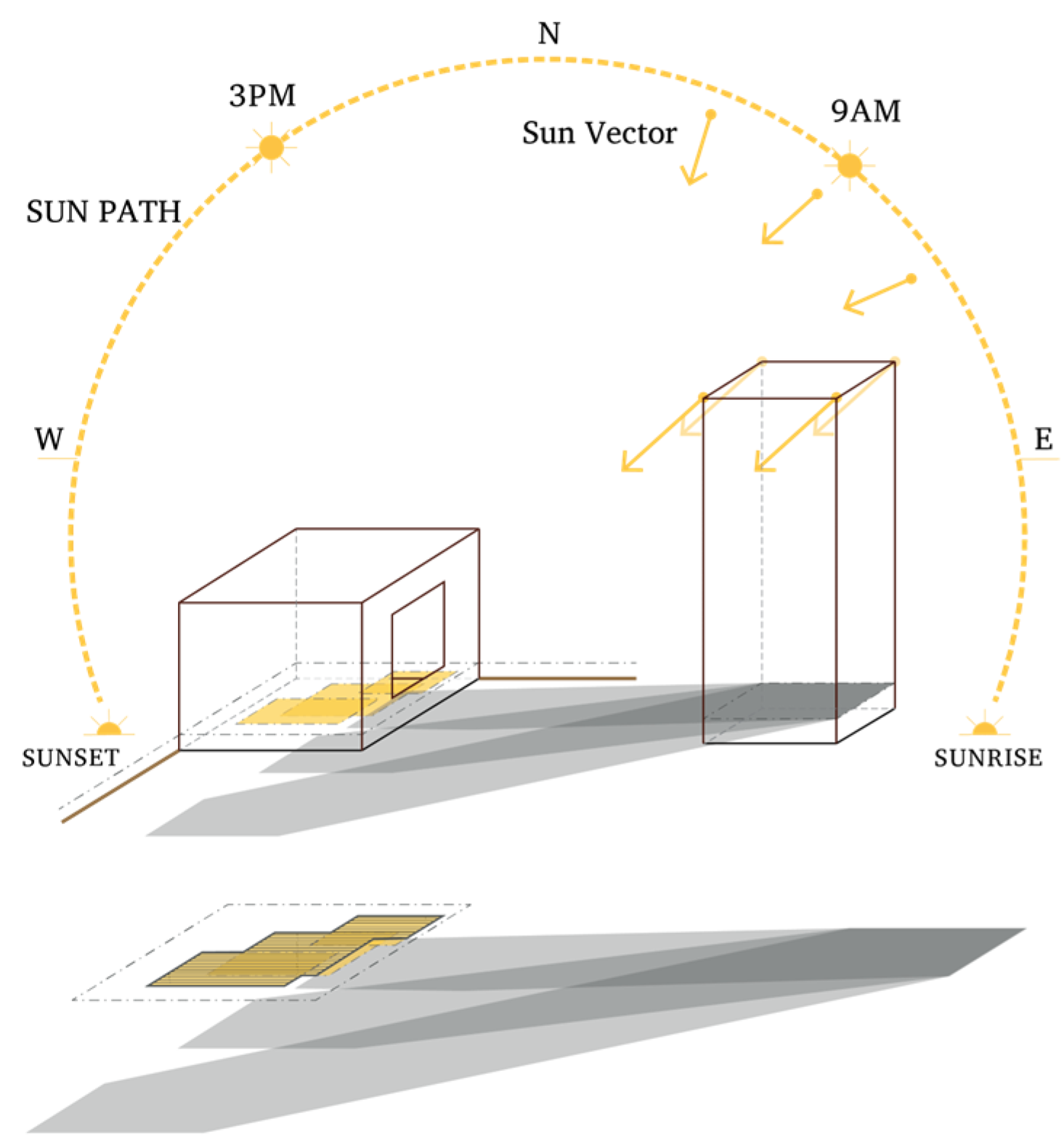
2.5. Reverse Sunlight Vector Method Concept
2.5.1. Creating the Receiver Object and Placing It on the Grid of the Surface That Will Receive Sunlight (Figure 6)
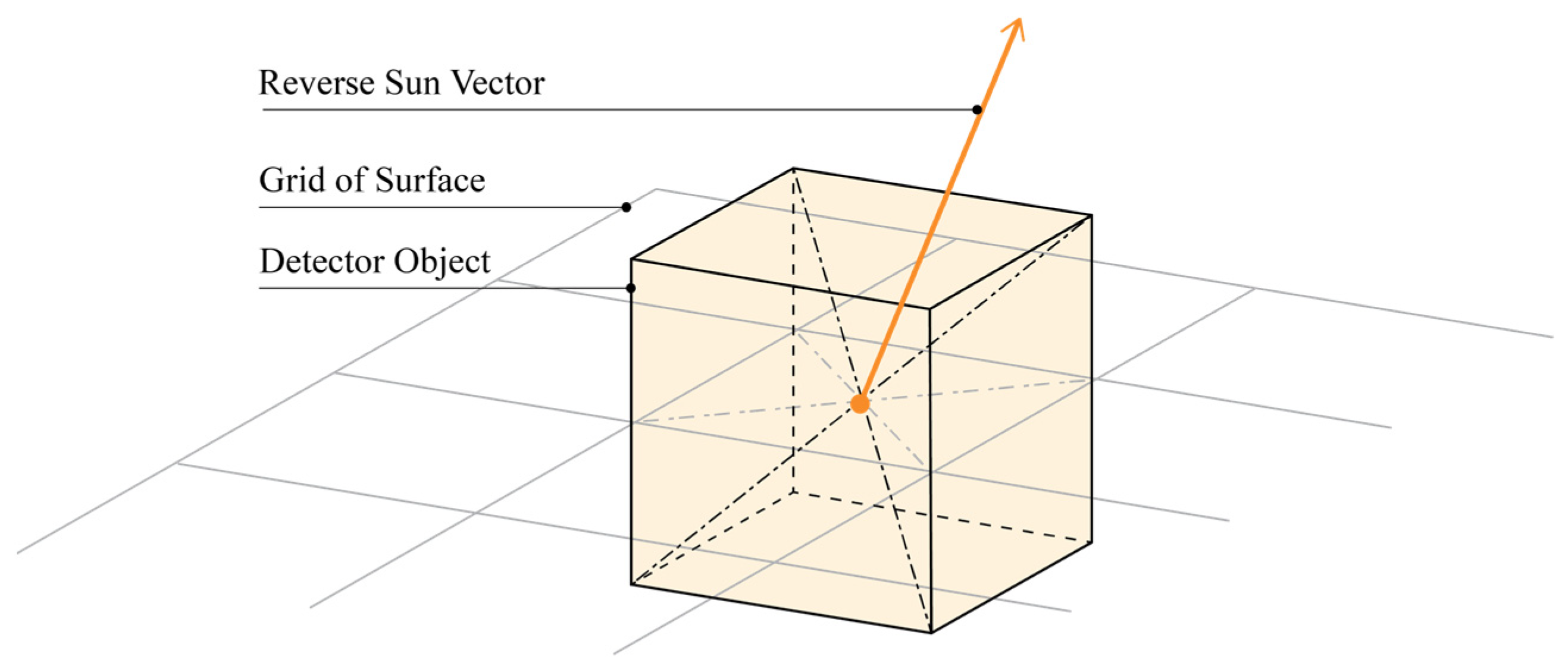
2.5.2. Checking for Clashes Between the Reverse Sunlight Vector and Any Obstacles and Recording the Data in the Receiver Parameters (Figure 7)
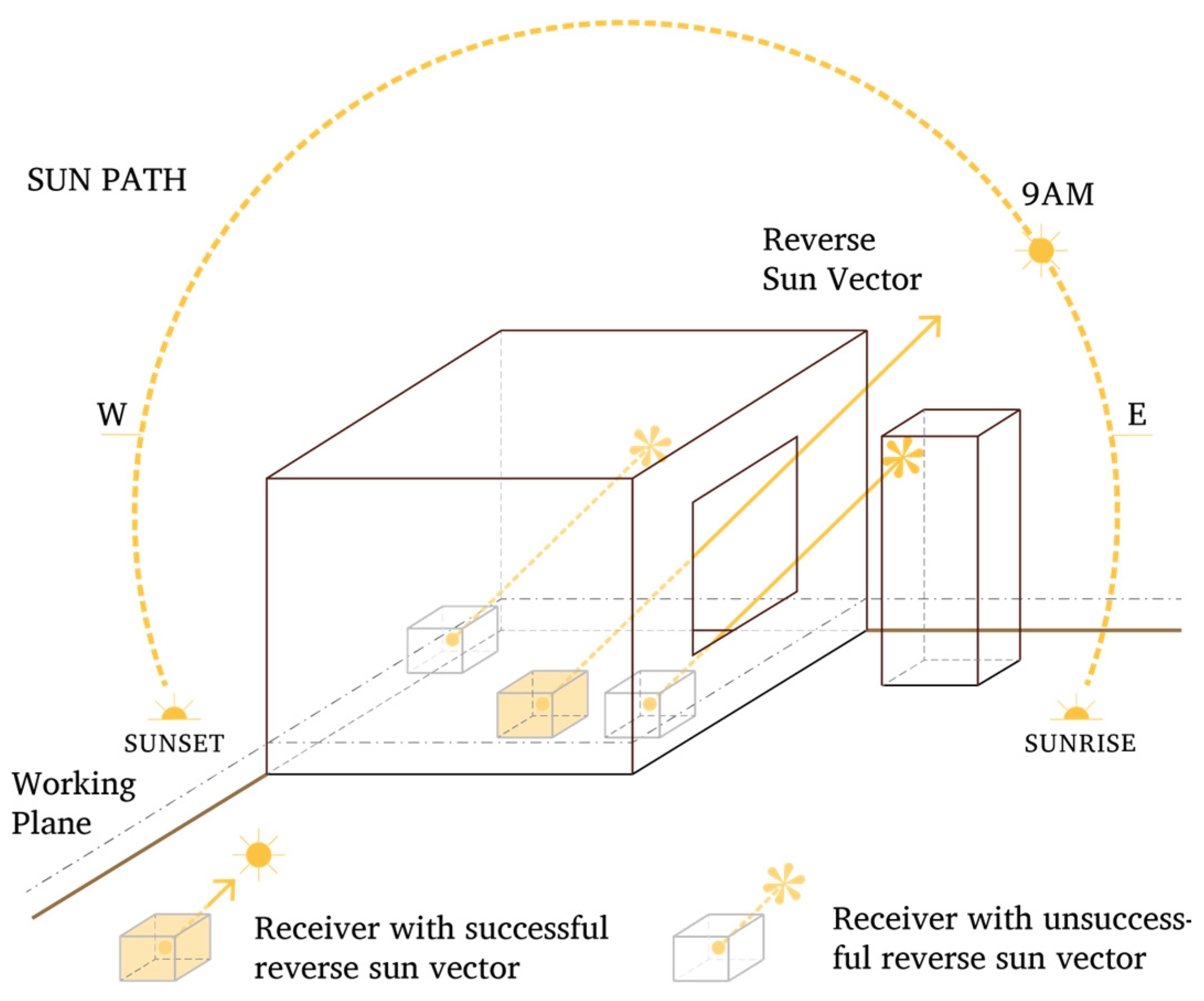
3. Results
3.1. Sunlight Vector Method Process
3.1.1. The First Phase: Modeling
3.1.2. The Second Phase: Programming Execution
- Module 1: Sun Position and Tracking Family Input;
- Module 2: Levels Input;
- Module 3: Top and Bottom Input for Surrounding Buildings;
- Module 4: Working Plane Generation;
- Module 5: Above-Floor and Surrounding Buildings’ Surfaces Generation;
- Module 6: Sunlight Areas Execution within Rooms;
- Module 7: Shadow Areas Calculation;
- Module 8: Sunlight Areas Calculation (by subtracting shadow areas).
3.1.3. Visual Output
3.1.4. The Conclusion About the Sunlight Vector Method
3.2. The Reverse Sunlight Vector Method Process
3.2.1. The First Phase: Modeling
3.2.2. The Second Phase: Programming Execution
- Module 1 (Figure A2): Select and Retrieve Receiver Locations: Module 1 imports all receiver families based on type using ‘Family.Types’. Filtering with ‘Element.GetParameterValueByName’, ‘String.Contain’, and ‘List.FilterByBoolMask’ identifies receiver locations in the project.
- Module 2 (Figure A3): Sun Position and Sunlight Vectors from EPW File: Seoul’s weather data, sourced from the EPW file, is imported into Dynamo. ‘Code block’ and ‘Calculate HOY’ determine the calculation time, exporting it to ‘SunPath’, which, in turn, provides sunlight vectors based on specified location and time.
- Module 3 (Figure A4): Obstacle Selection and Union: Module 3 treats all project objects as obstacles, utilizing ‘Select Model Elements’, ‘Element.Geometry’, ‘List.Flatten’, and ‘Solid.ByUnion’ to convert input objects into a single solid object.
- Module 4 (Figure A5): Create Reverse Sunlight Vectors: Module 4 reverses sunlight vectors from Module 2 using ‘Vector.Reverse’, generating reverse sunlight vectors based on receiver locations. These vectors are crucial for clash detection in Module 5.
- Modules 5 and 6 (Figure A6): Clash Detection and Result Recording: Modules 5 and 6, the final stages, employ ‘Geometry.DoesIntersect’ to detect clashes between reverse sunlight vectors and obstacles. If no intersection occurs, the corresponding receiver accumulates an additional sunlight hour in the “sun hour” parameter.
3.2.3. Visual Output
3.2.4. Accuracy Checking
3.2.5. The Third Phase: Output Data Execution
3.3. The Direct Sun Index
4. Discussion
- The reverse sunlight vector method (Revit modeling and coding in Dynamo) took approximately 45 min for one building.
- Insight (Revit modeling and Insight on cloud) was the third in speed due to the slow upload and download of files, and it delivered sun hours without area data.
- Ladybug and Honeybee (Rhino modeling, coding in Grasshopper) were nearly the same as the reverse sunlight vector method but did not support numerical data output. At least two more programs were needed to achieve figure output (creating room space and exporting Excel data), along with more plugins (TT.Toolbox, Lunchbox, etc.), and complicated coding. Additionally, it required more modeling work to create room spaces.
5. Conclusions
Author Contributions
Funding
Data Availability Statement
Conflicts of Interest
Appendix A
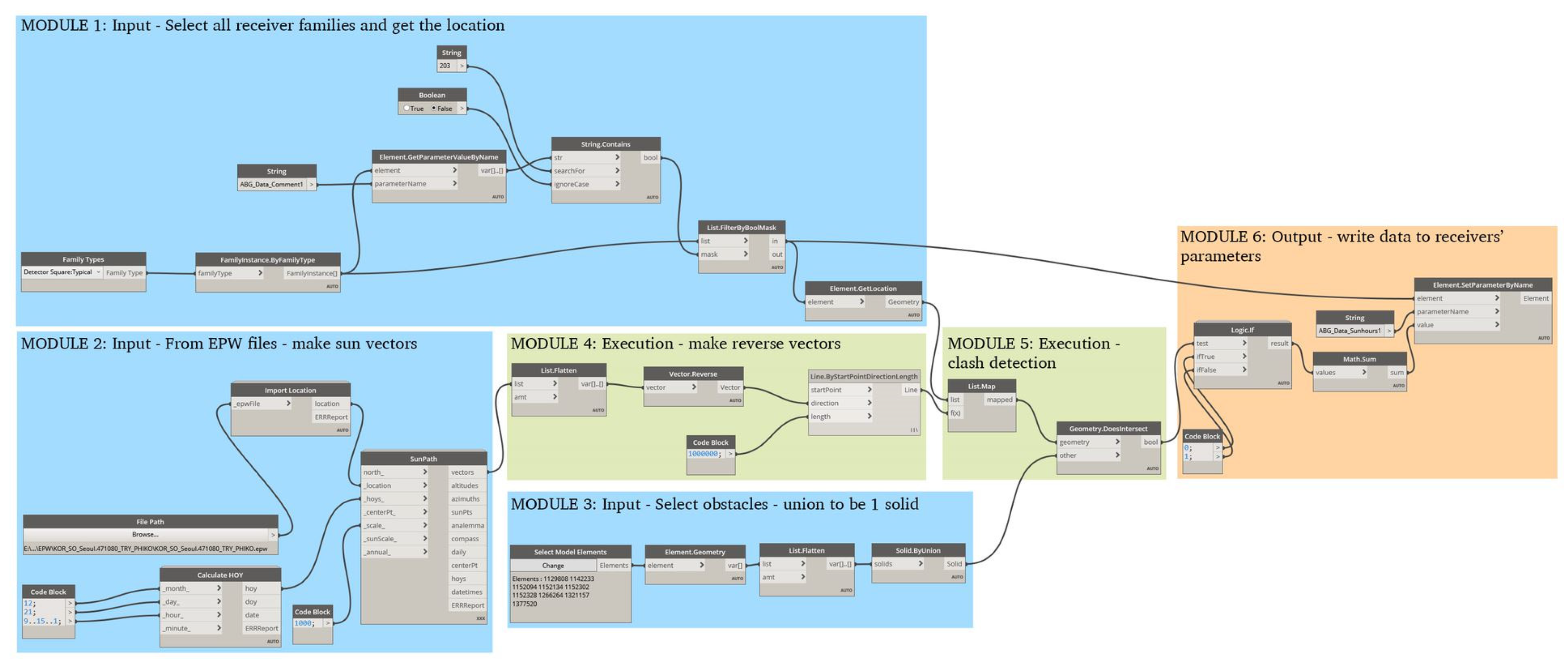




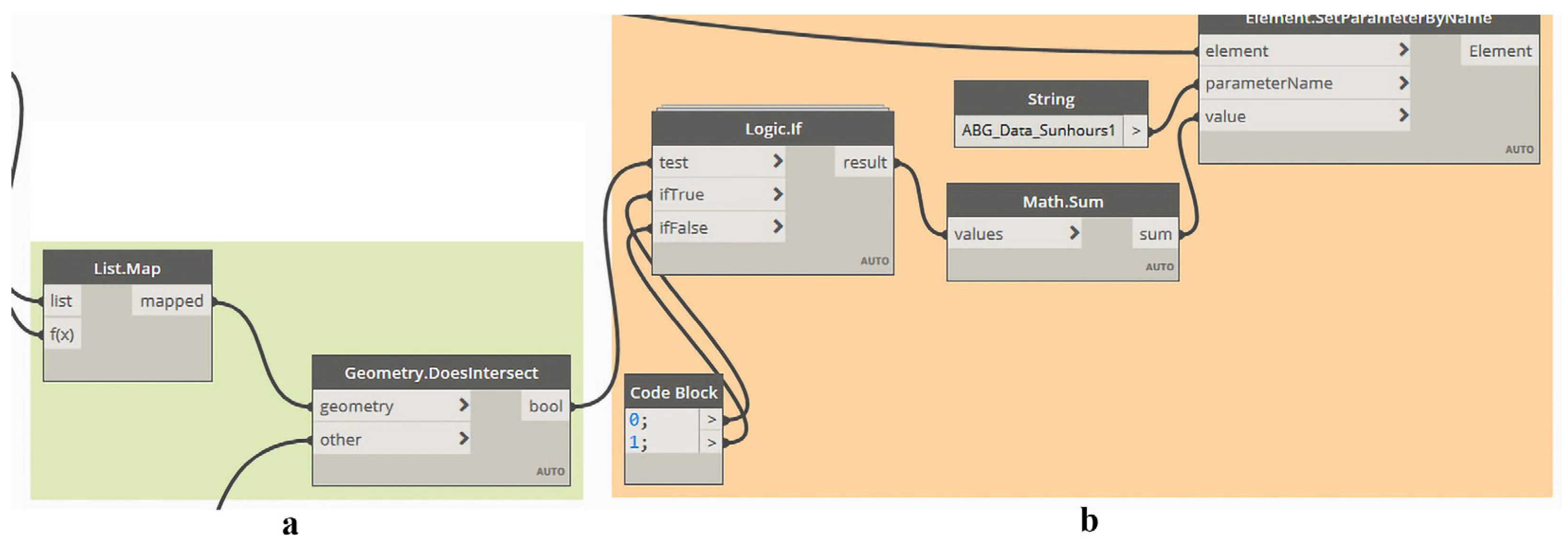
Appendix B


References
- Konstantzos, I.; Sadeghi, S.A.; Kim, M.; Xiong, J.; Tzempelikos, A. The effect of lighting environment on task performance in buildings—A review. Energy Build. 2020, 226, 110394. [Google Scholar] [CrossRef]
- Horvat, M.; Kanters, J. T.41.B.4: Needs of Architects Regarding Digital Tools for Solar Building Design; The International Energy Agency (IEA)—The Solar Heating and Cooling Technology Collaboration Programme (SHC): Cedar, MI, USA, 2012. [Google Scholar]
- Government of the Netherlands. Bouwbesluit 2012 [Building Decree 2012]. 2012. Available online: https://wetten.overheid.nl/BWBR0030461 (accessed on 31 December 2023).
- Ministerstwo Infrastruktury [Ministry of Infrastructure]. Rozporządzenie w Sprawie Warunków Technicznych, Jakim Powinny odpowiadać Budynki i Ich Usytuowanie [Regulation on the Technical Conditions to be Met by Buildings and Their Location]. 2002. Available online: https://isap.sejm.gov.pl/isap.nsf/DocDetails.xsp?id=WDU20020750690 (accessed on 31 December 2023).
- Vlada Republike Slovenije [Government of Slovenia]. Pravilnik o Minimalnih Tehničnih Zahtevah za Graditev Stanovanjskih Stavb in Stanovanj [Rules on Minimum Technical Requirements for Residential Buildings], Official Gazette RS, No. 61/17. 2017. Available online: https://www.uradni-list.si/glasilo-uradni-list-rs/vsebina/2017-01-3046 (accessed on 31 December 2023).
- GB 50180-93; Code for Planning and Design of Urban Residential Areas. Ministry of Housing and Urban-Rural Development of the PRC: Beijing, China, 1993. Available online: http://www.mohurd.gov.cn (accessed on 31 December 2023).
- Government of Japan. Building Standard Law. 2022. Available online: https://elaws.e-gov.go.jp/document?lawid=325AC0000000201 (accessed on 31 December 2023).
- New South Wales Government. State Environmental Planning Policy No. 65—Design Quality of Residential Apartment Development; SEPP 65; New South Wales Government: Sydney, Australia, 2015. Available online: https://legislation.nsw.gov.au/view/html/inforce/current/epi-2002-0530 (accessed on 31 December 2023).
- Department of Environment, Land, Water and Planning (DELWP). Better Apartments Design Standards. 2017. Available online: https://www.planning.vic.gov.au/guides-and-resources/guides/all-guides/better-apartments (accessed on 31 December 2023).
- Ministry of Government Legislation. Enforcement Decree of the Building Act. 2024. Available online: https://www.law.go.kr/법령/건축법시행령/제86조 (accessed on 31 December 2023).
- Statistics Korea. Housing Type by Administrative District (2023); KOSIS: Korea Statistical Information Service: Daejeon, Republic of Korea, 2023. Available online: https://kosis.kr/statHtml/statHtml.do?orgId=116&tblId=DT_MLTM_5403&conn_path=I2&language=en (accessed on 31 December 2023).
- Kim, S.H. High density dilemmas: Apartment development vs. urban management plan in Seoul. Seoul Urban Stud. 2018, 19, 1–19. [Google Scholar]
- Lee, S.-Y. Urban residents battle for sunlight. The Korea Times, 22 January 2020. Available online: https://www.koreatimes.co.kr/southkorea/society/20200122/urban-residents-battle-for-sunlight (accessed on 31 December 2023).
- IES Daylight Metrics Committee. Approved Method: IES Spatial Daylight Autonomy (sDA) and Annual Sunlight Exposure (ASE); IES-USA: New York, NY, USA, 2012. [Google Scholar]
- Aksamija, A. Methods for integrating parametric design with building performance analysis. ARCC Conf. Repos. 2018. Available online: https://www.arcc-journal.org/index.php/repository/article/view/459/363 (accessed on 14 October 2025).
- Garcia, M.S.; Freitas, M.L.M.; Souza, R.V.G.; Veloso, A.C.O. Comparison of daylighting simulation workflows and results using plugins for BIM and 3D Modeling programs: Application on early phases of design process. In Proceedings of the 7th International Building Physics Conference, IBPC2018—Healthy, Intelligent and Resilient Buildings and Urban Environments, Syracuse, NY, USA, 23–26 September 2018. [Google Scholar] [CrossRef]
- Ghobad, L. Daylighting and energy simulation workflow in performance based building simulation tools. In Proceedings of the 2018 Building Performance Analysis Conference and Simbuild, Chicago, IL, USA, 26–28 September 2018. [Google Scholar]
- Spiridigliozzi, G.; Pompei, L.; Cornaro, C.; De Santoli, L.; Bisegna, F. BIM-BEM support tools for early stages of zero-energy building design. IOP Conf. Ser. Mater. Sci. Eng. 2019, 609, 072075. [Google Scholar] [CrossRef]
- Awad, J.; Abd-Rabo, L. Daylight and Energy Performance Optimization in Hot—Arid Regions: Application and adaptation guide for designers in the UAE. Procedia Manuf. 2020, 44, 237–244. [Google Scholar] [CrossRef]
- Ministry of Land, Infrastructure and Transport. Article 86 (Restriction on Height of Buildings for Securing Sunshine, etc.). In Enforcement Decree of the Building Act; Korea Legislation Research Institute: Sejong, Republic of Korea, 1992. [Google Scholar]
- ENSW Department of Planning and Environment. Objective 4A-1. In Apartment Design Guide: Tools for Improving the Design of Residential Apartment Development; NSW Department of Planning and Environment: Sydney, Australia, 2015; p. 79. [Google Scholar]


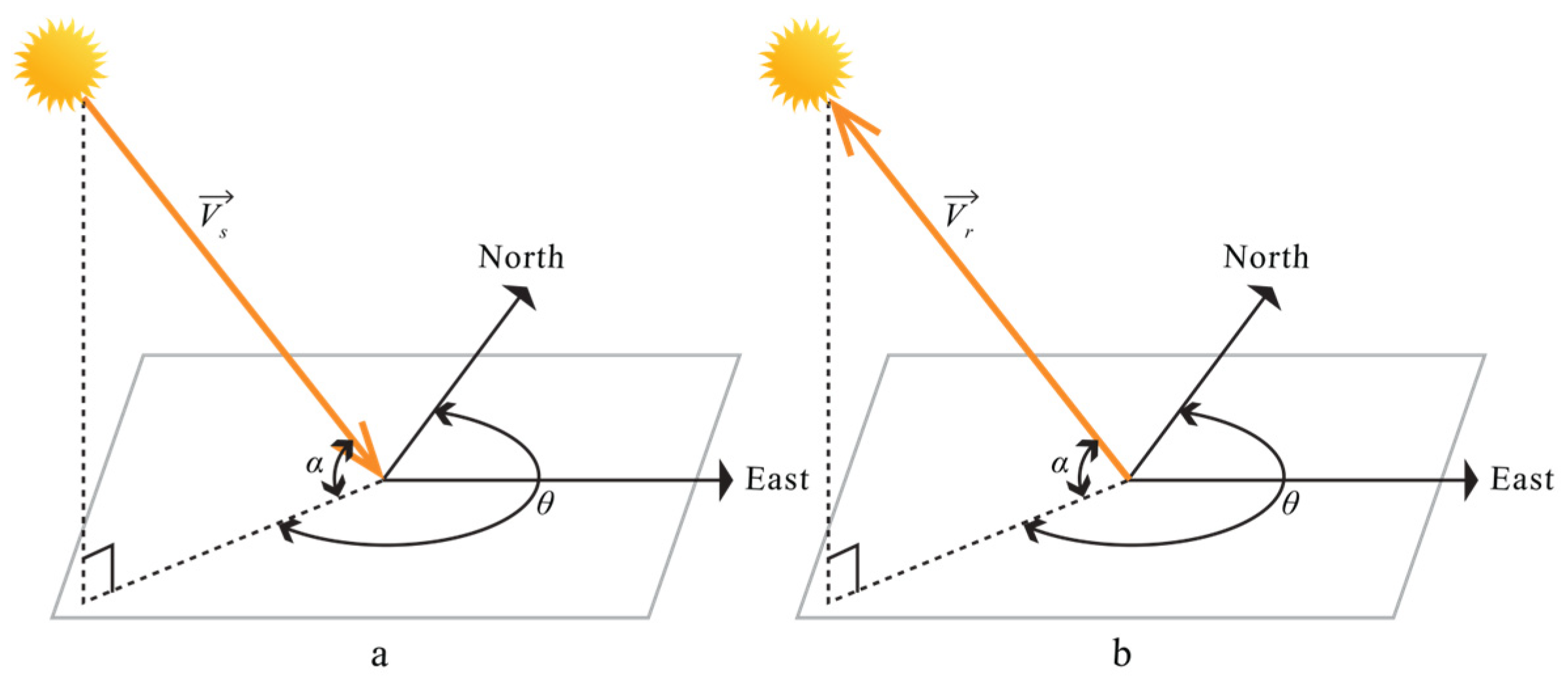
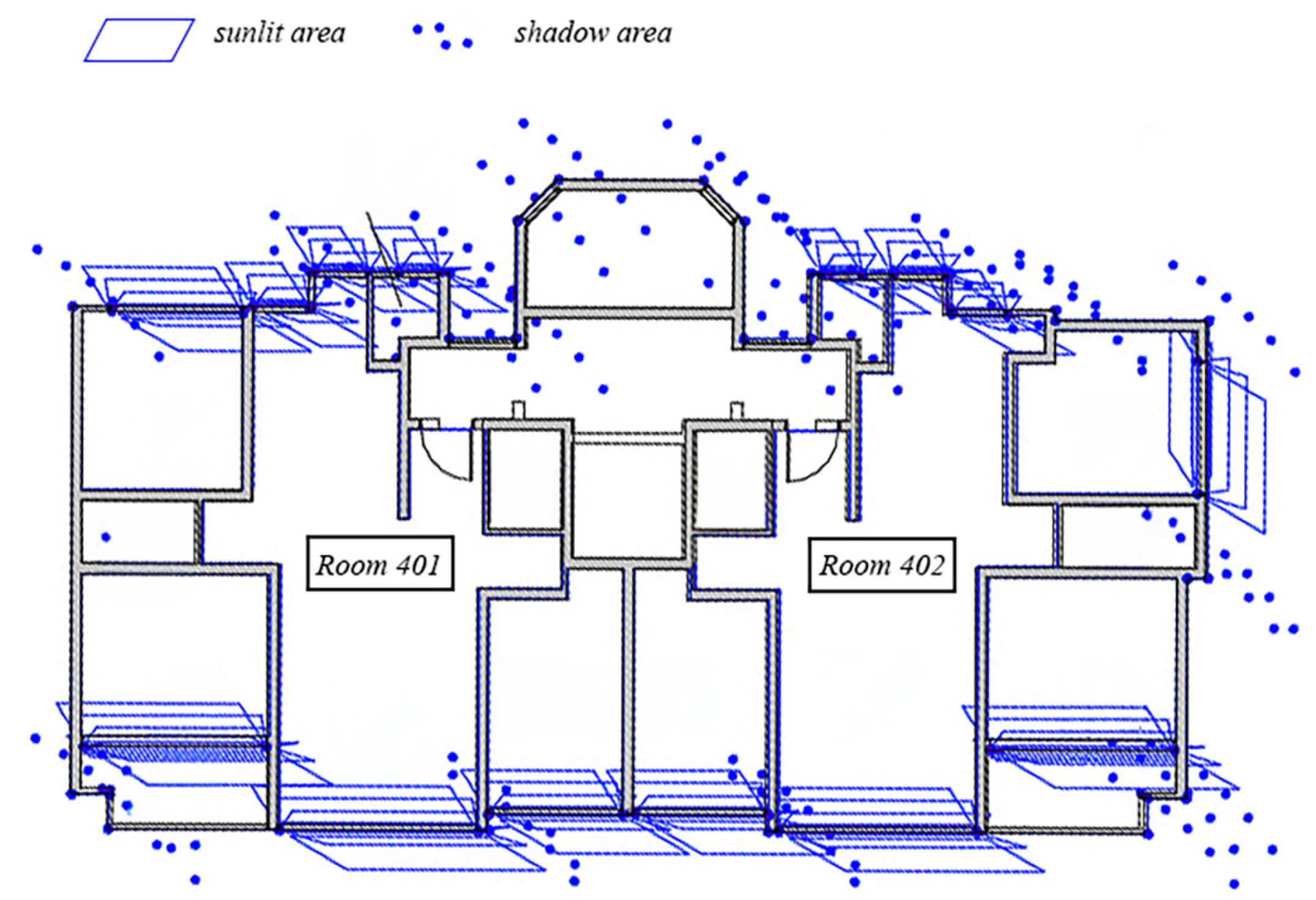
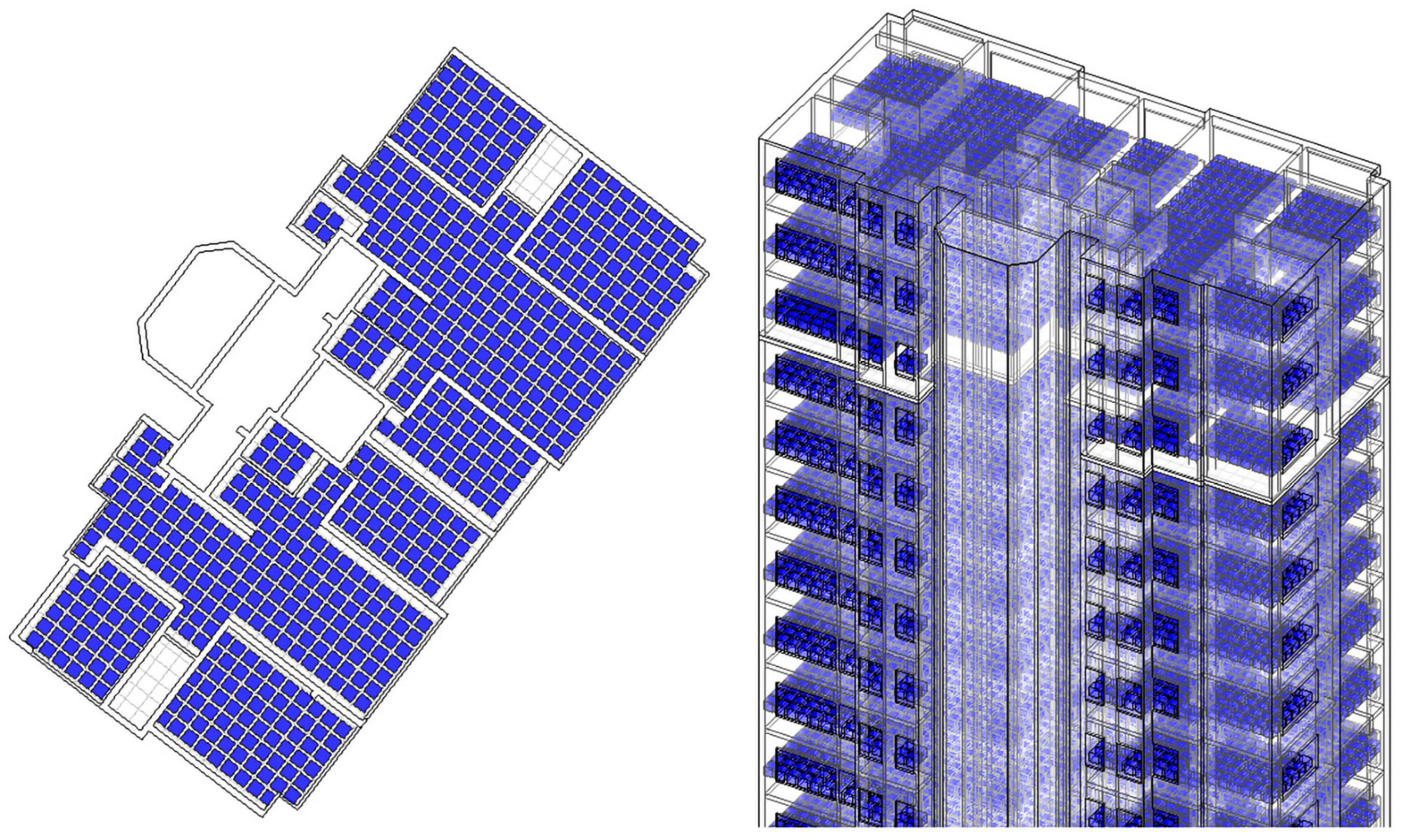
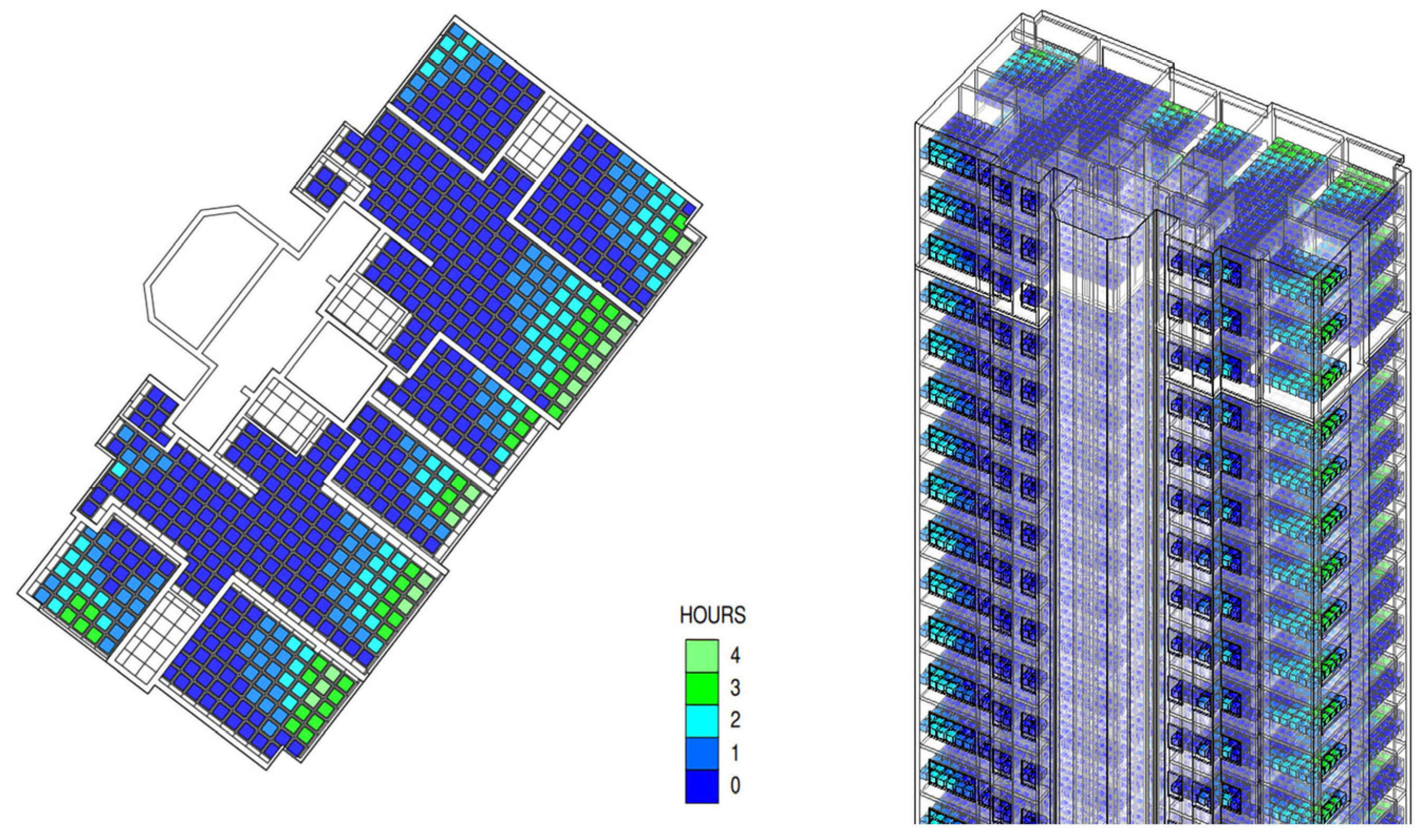
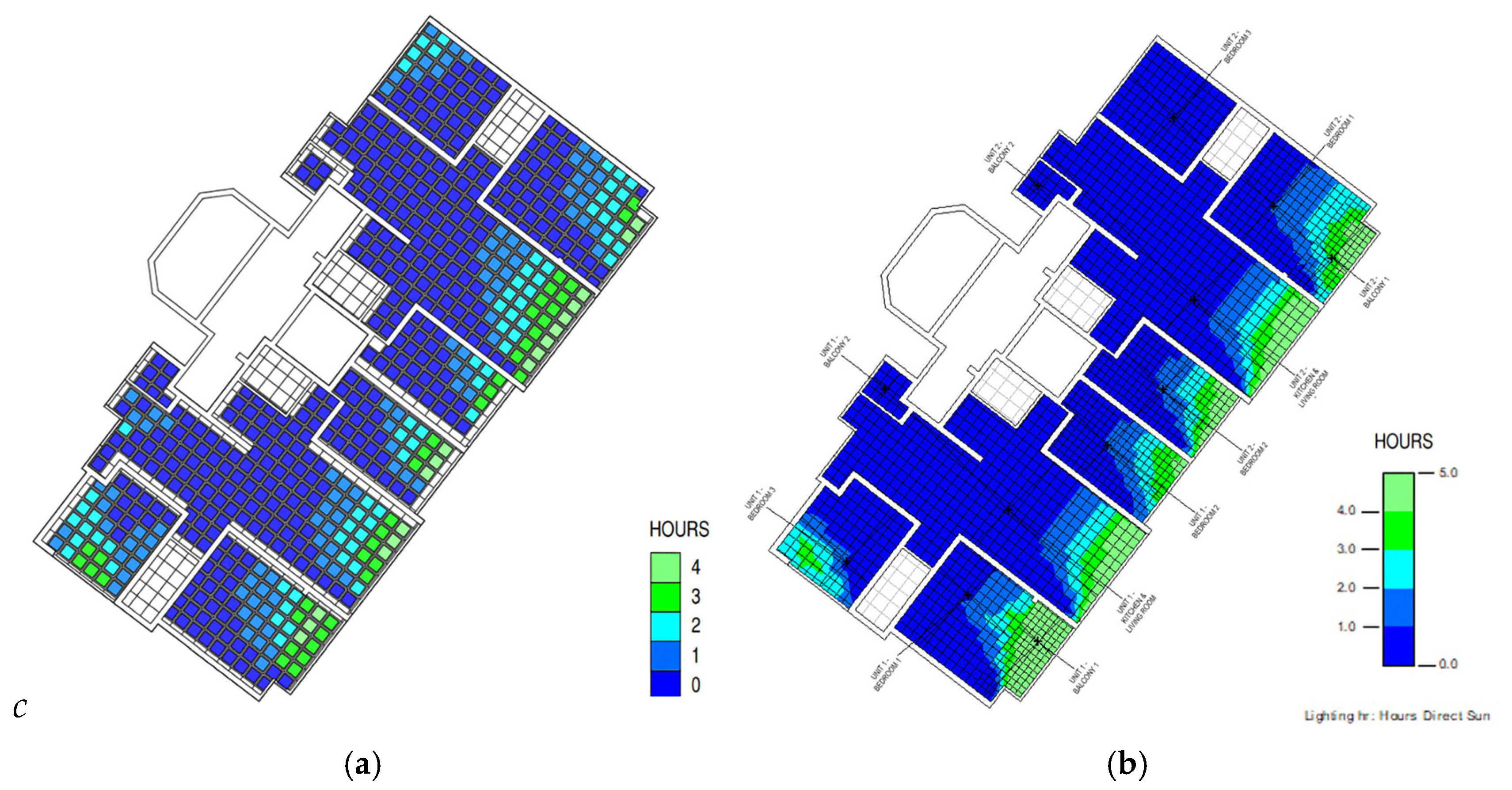

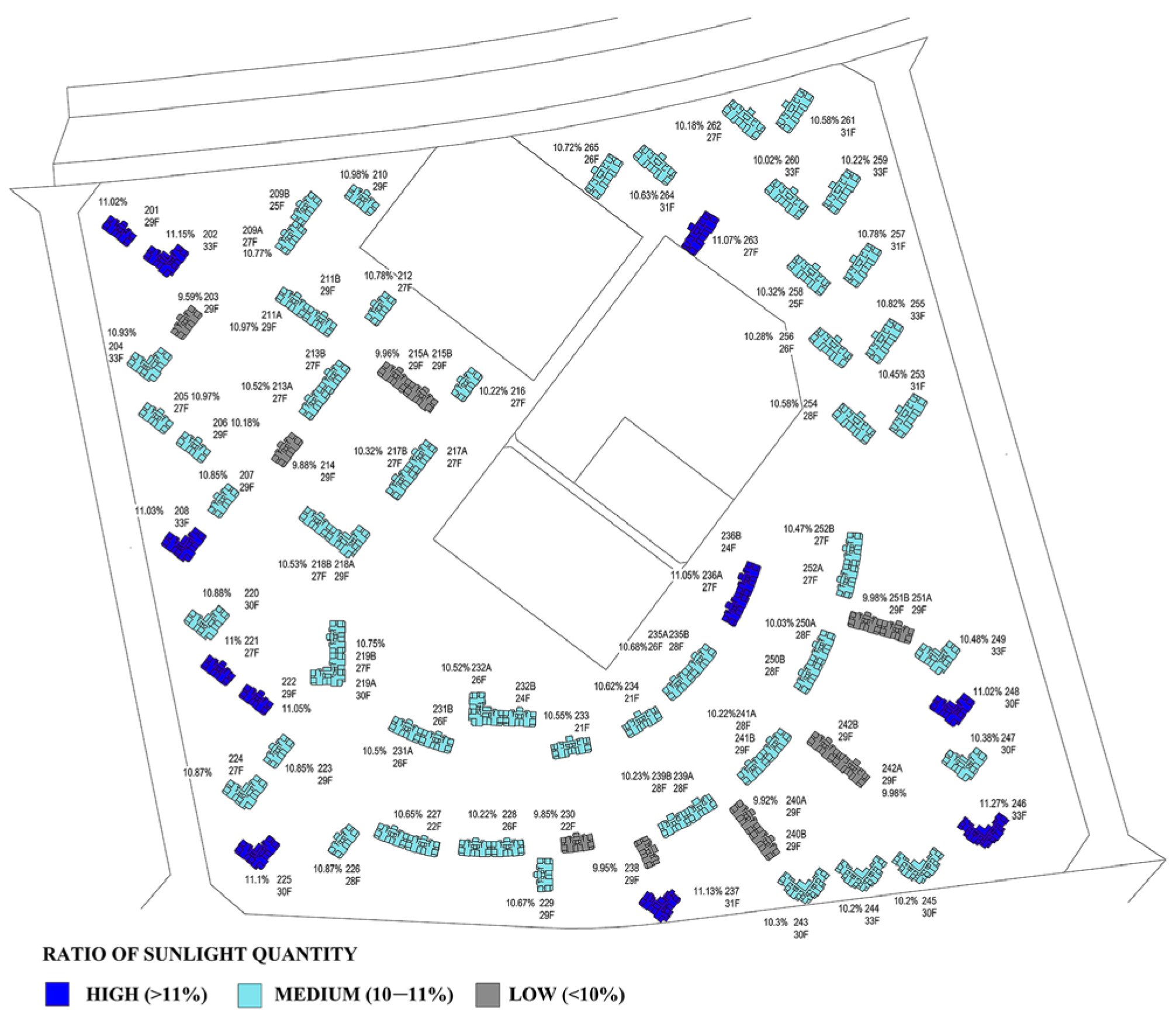

| Insight for Revit | Ladybug + Honeybee | Sefaira for Sketchup | ||
|---|---|---|---|---|
| Grasshopper/Rhino | Dynamo/Revit | |||
| Applicable Standard | LEED, SEPP65, sDA & ASE | Flexible by programming | sDA & ASE | |
| Validated | Green Building Studio, EnergyPlus—ANSI/ASHRAE 140; Radiance and real-world measurements | Radiance, EnergyPlus, OpenStudio, Therm and OpenFOAM | Cannot find the validation | |
| Cost | $150/100 cloud credits | Free | $899 | |
| Analysis Surface | Only Plan | Any surface | Any surface | |
| Result | Graphical plan. Support schedule of sun hour data, No area data | Graphical plan, Not support schedule. | Graphical plan Not support schedule. | |
| Customization Capabilities | Cloud-based Few modification capabilities | Many. Coding environment | Few. Only support 1 room/analysis | Cloud-based Few modification capabilities |
| General Speed | Fast in execution, and modelling but slow in uploading to a cloud server | Fast in execution but slow in the modelling phase | Fast but slow in uploading to the cloud | |
| BIM support | Yes | No | No | |
| Room Name | Reverse Vector Method Result: | Insight Result: | ||
|---|---|---|---|---|
| Sunlight Hour | Sunlit Area (m2) | Hours Direct Solar | PASS | |
| 2701—balcony 1 | 4 | 11.25 | 4 | YES |
| 2701—balcony 2 | 0 | 0.00 | 0 | NO |
| 2701—bedroom 1 | 2 | 5.25 | 2 | YES |
| 2701—bedroom 2 | 4 | 9.50 | 4 | YES |
| 2701—bedroom 3 | 3 | 12.50 | 3 | NO |
| 2701—living room & kitchen | 4 | 18.25 | 4 | YES |
| 2702—balcony 1 | 4 | 8.00 | 4 | YES |
| 2702—balcony 2 | 0 | 0.00 | 0 | NO |
| 2702—bedroom 1 | 2 | 5.25 | 2 | NO |
| 2702—bedroom 2 | 3 | 5.75 | 3 | YES |
| 2702—bedroom 3 | 2 | 4.75 | 2 | NO |
| 2702—living room & kitchen | 4 | 26.50 | 4 | YES |
| Room Name | Daily Direct Sunlight Area (m2. h) | Area (m2) | Daily Direct Sunlight Ratio (%) |
|---|---|---|---|
| Balcony 1 | 11.25 | 5 | 37.50% |
| Balcony 2 | 0 | 2 | 0% |
| Bathroom 1 | 0 | 3 | 0% |
| Bathroom 2 | 0 | 3 | 0% |
| Bedroom 1 | 5.25 | 13 | 6.73% |
| Bedroom 2 | 9.5 | 11 | 14.39% |
| Bedroom 3 | 12.5 | 11 | 18.94% |
| Living Room & Kitchen | 18.25 | 42 | 7.24% |
| Total | 56.75 (Au) | 90 (Su) | 10.5% (Ru) |
| Building | Average of Accumulated Sunlit Area Per Level (m2) (Aavg) | Yearly Direct Sunlight Ratio (%) (r) |
|---|---|---|
| Building 201 | 441.8 | 11.02% |
| Building 202 | 447.0 | 11.15% |
| Building 203 | 384.5 | 9.59% |
| Building 204 | 438.2 | 10.93% |
| Building 205 | 439.8 | 10.97% |
| Building 206 | 408.1 | 10.18% |
| Building 207 | 435.0 | 10.85% |
| […] | ||
| Building 260 | 394.9 | 9.85% |
| Building 261 | 424.2 | 10.58% |
| Building 262 | 408.1 | 10.18% |
| Building 263 | 425.8 | 10.62% |
| Building 264 | 426.2 | 10.63% |
| Building 265 | 429.8 | 10.72% |
| Step of Calculation | Scale of Calculation | Useful for |
|---|---|---|
| 1 | Unit | Residents |
| 2 | Building | Both residents & architect |
| 3 | Complex | Architects, urban planners, politicians |
| Level | Unit | Sunlit Area (m2) | Unit | Sunlit Area (m2) |
|---|---|---|---|---|
| 1 | 0101 | 295.489 | 0102 | 313.152 |
| 2 | 0201 | 295.489 | 0202 | 313.152 |
| 3 | 0301 | 295.489 | 0302 | 313.152 |
| 4 | 0401 | 295.489 | 0402 | 313.152 |
| 5 | 0501 | 295.489 | 0502 | 314.303 |
| 6 | 0601 | 295.489 | 0602 | 314.303 |
| 7 | 0701 | 295.489 | 0702 | 314.303 |
| 8 | 0801 | 295.489 | 0802 | 314.303 |
| 9 | 0901 | 297.081 | 0902 | 315.309 |
| 10 | 1001 | 297.081 | 1002 | 315.309 |
| 11 | 1101 | 297.081 | 1102 | 315.309 |
| 12 | 1201 | 297.081 | 1202 | 315.309 |
| 13 | 1301 | 297.081 | 1302 | 315.649 |
| 14 | 1401 | 297.081 | 1402 | 315.812 |
| 15 | 1501 | 297.081 | 1502 | 315.812 |
| 16 | 1601 | 297.081 | 1602 | 315.812 |
| 17 | 1701 | 297.081 | 1702 | 316.208 |
| 18 | 1801 | 297.081 | 1802 | 316.208 |
| 19 | 1901 | 297.081 | 1902 | 316.208 |
| 20 | 2001 | 297.081 | 2002 | 316.208 |
| 21 | 2101 | 297.081 | 2102 | 322.035 |
| 22 | 2201 | 297.081 | 2202 | 322.035 |
| 23 | 2301 | 297.081 | 2302 | 322.035 |
| 24 | 2401 | 298.548 | 2402 | 333.69 |
| 25 | 2501 | 298.548 | 2502 | 333.69 |
| 26 | 2601 | 298.548 | 2602 | 333.69 |
| 27 | 2701 | 298.548 | 2702 | 337.146 |
| 28 | 2801 | 298.55 | 2802 | 337.484 |
| 29 | 2901 | 298.55 | 2902 | 337.484 |
| Units with max direct sunlight area | 2902, 2802, 2702 | |||
| Units with min direct sunlight area | 0101, 0201, 0301, 0401, 0501, 0601 | |||
Disclaimer/Publisher’s Note: The statements, opinions and data contained in all publications are solely those of the individual author(s) and contributor(s) and not of MDPI and/or the editor(s). MDPI and/or the editor(s) disclaim responsibility for any injury to people or property resulting from any ideas, methods, instructions or products referred to in the content. |
© 2025 by the authors. Licensee MDPI, Basel, Switzerland. This article is an open access article distributed under the terms and conditions of the Creative Commons Attribution (CC BY) license (https://creativecommons.org/licenses/by/4.0/).
Share and Cite
Luc, H.B.P.; Nguyen, T.T.; Kim, D.-h. Direct Sunlight Analysis: A Simplified Approach to Complex Residential Design. Buildings 2025, 15, 4053. https://doi.org/10.3390/buildings15224053
Luc HBP, Nguyen TT, Kim D-h. Direct Sunlight Analysis: A Simplified Approach to Complex Residential Design. Buildings. 2025; 15(22):4053. https://doi.org/10.3390/buildings15224053
Chicago/Turabian StyleLuc, Hung Ba Phuc, Trang Thao Nguyen, and Dong-hyun Kim. 2025. "Direct Sunlight Analysis: A Simplified Approach to Complex Residential Design" Buildings 15, no. 22: 4053. https://doi.org/10.3390/buildings15224053
APA StyleLuc, H. B. P., Nguyen, T. T., & Kim, D.-h. (2025). Direct Sunlight Analysis: A Simplified Approach to Complex Residential Design. Buildings, 15(22), 4053. https://doi.org/10.3390/buildings15224053






